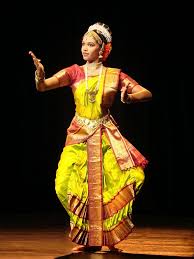Bharatanatyam

Bharatanatyam is one of the oldest and most revered classical dance forms of India, originating in Tamil Nadu. Rooted in the Natya Shastra, an ancient treatise on performing arts, it combines intricate footwork, graceful hand gestures (mudras), and expressive facial movements to narrate stories, often derived from Hindu mythology.
Key Features:
- Expression (Abhinaya): Central to Bharatanatyam is its storytelling aspect, where dancers convey emotions and narratives through facial expressions, gestures, and body movements.
- Rhythm (Nritta): This is the pure dance aspect, focusing on complex rhythmic patterns and precise footwork.
- Drama (Natya): A blend of dance and acting, Natya emphasizes dramatic storytelling.
- Costume: Dancers wear vibrant, pleated silk sarees adorned with gold borders, intricate jewelry, and flowers in their hair. The costume enhances the visual appeal of movements.
- Music: Bharatanatyam is performed to Carnatic music, accompanied by instruments like the mridangam, violin, and flute. The songs often praise deities or recount mythological tales.
- Postures and Movements: The dance employs geometric movements, angular postures, and symmetrical lines, emphasizing grace and discipline.
Bharatanatyam is both a spiritual and a performative art form, traditionally performed in temples as an offering to deities but now also showcased on global stages. It symbolizes a blend of devotion, discipline, and artistic expression.

Nandini
Lorem ipsum dolor sit amet, consectetur adipiscing elit. Ut elit tellus, luctus nec ullamcorper mattis, pulvinar dapibus leo.

Nandini
Lorem ipsum dolor sit amet, consectetur adipiscing elit. Ut elit tellus, luctus nec ullamcorper mattis, pulvinar dapibus leo.

Nandini
Lorem ipsum dolor sit amet, consectetur adipiscing elit. Ut elit tellus, luctus nec ullamcorper mattis, pulvinar dapibus leo.

Nandini
Lorem ipsum dolor sit amet, consectetur adipiscing elit. Ut elit tellus, luctus nec ullamcorper mattis, pulvinar dapibus leo.